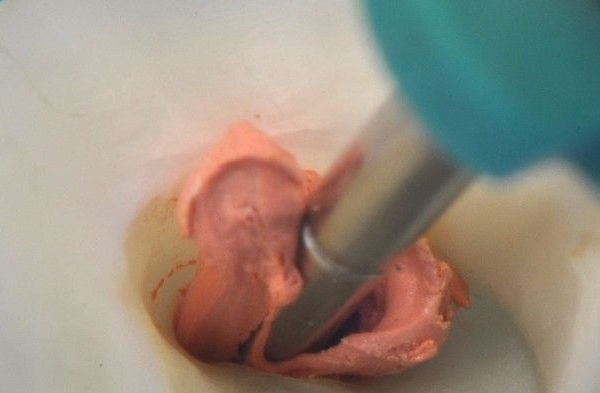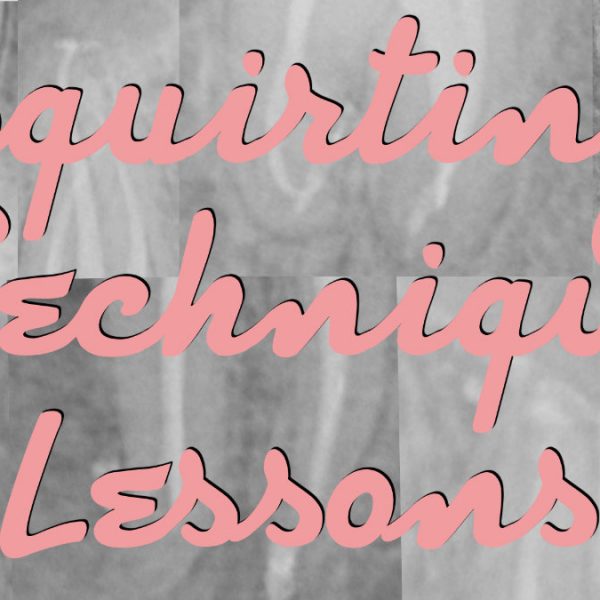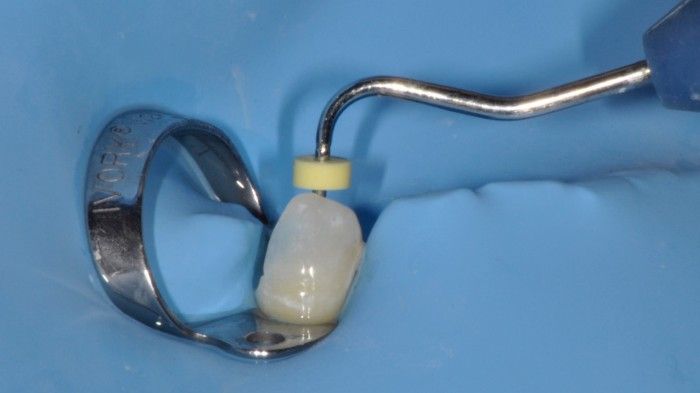
Root Canal Filling Systems: Warm Vertical Condensation
04/11/2016
Calogero Bugea
Warning: Undefined variable $post in /var/www/vhosts/styleitaliano-endodontics.org/endodontics.styleitaliano.org/wp-content/plugins/oxygen/component-framework/components/classes/code-block.class.php(133) : eval()'d code on line 2
Warning: Attempt to read property "ID" on null in /var/www/vhosts/styleitaliano-endodontics.org/endodontics.styleitaliano.org/wp-content/plugins/oxygen/component-framework/components/classes/code-block.class.php(133) : eval()'d code on line 2
Root canal filling systems represents the culmination and of a series of procedural steps. All dentists show a lot of interest when endodontic post-treatment radiographs exhibit puffs, filled accessory canals or shown a particular anatomy, like a isthmus or an accessory canal; cleaned but not shaped.
The vertical compaction technique of warm gutta-percha, conceived and described by Schilder in 1967, combines a reasonable ease of execution with maximal efficacy in obturating both simple and more complex canals. The objective of the vertical condensation technique is to continuously and progressively carry a wave of warm gutta percha along the length of the master cone, starting coronally and ending in apical corkage

Fig. 1
The first step is a correct cone selection, this step is very important and an article by the same Author has been published at the following link:
Article: Obturation, Step No. 1: Cone Fit
After a diagnostic working rx should confirm the desired position of the master cone and verify all the previous operative steps, the GP cone must be shortened with microscissors because during the compactation, gutta-percha cone move apically, and its tip will become engaged in progressively smaller portions of canal.
In wide, straight root canals, where pluggers easily go down to the apical portion and where it will therefore be easy to move the guttapercha apically, it is better to shorten it more, by at least 1-2 mm.

Fig. 2
In narrower, more curved canals, in which the pluggers descend less and it will be more difficult to move the gutta-percha apically, one must shorten the cone by only a few fractions of a millimeter, so as not to risk a short obturation.

Fig. 3
In case of wide canals or elliptical canals, it is advisable to introduce a supplemental cone alongside the master cone for added bulk of gutta-percha to compact apically

Fig. 4
Usually 3 pluggers are needed to perform the obturation. A wide Plugger like Matchou 3 for the coronal third, a medium pluggher like Matchou 1 or 2 for the medium third and a narrower plugger like Shilder #8 which descends into the apical one third until about 3-5 mm from the apical foramen.
The pluggers are inserted and then they must be prefitted into the canal to determine the depth to which they can be introduced without touching the dentinal walls. The essence of the technique is to capture the maximal cushion of softened gutta-percha and to compact it vertically.
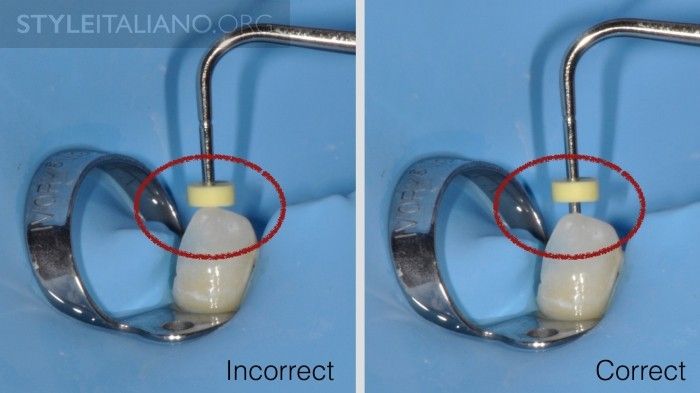
Fig. 5
The plugger has been supplied with a rubber stop, the instrument is introduced into the canal and stop when it contact the dentin. It's important that during compactation plugger don't reach this lenght, we must work short during compartation or move the stop during this step just before the instrument touches the dentinal walls (usually 1 mm).
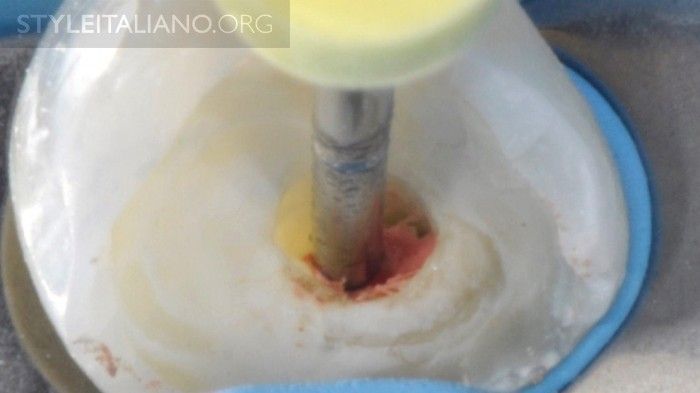
Fig. 6
A wide plugger captures the largest amount of gutta-percha, compacting it not only apically but also, without any force, laterally.

Fig. 7
A plugger of smaller size to compact a wide surface of gutta-percha, the instrument would sink into the heat-softened material without exerting any pressure.

Fig. 8
The pluggers must never touch the dentinal walls, because if they did so they would no longer exert any pressure on the gutta-percha, while they could cause a root fracture by their wedging action.
SEALER AND MASTER CONE PLACEMENT
Kerr Pulp Canal Sealer EWT (Extended Working Time) (Henry Schein) has been specifically formulated for the warm gutta percha with vertical condensation technique and affords several advantages. These include:
1) Superior lubrication and flow
2) Adjustable viscosity
3) Dimensionally inert
4) Essentially non-resorbable
5) Sets in the presence of heat
6) Inhibits prostaglandins
7) Biocompatible

Fig. 9
A fresh mix of Kerr Pulp Canal Sealer EWT completely sets extraorally within 30 minutes. Intraorally, this sealer sets even more rapidly, which advantageously serves to reduce an inflammatory post-obturation response directly related to a sealer puff or surplus material after filling. The correct consistence of the sealer is like a creamy mixture and we have the possibility to make at least a 2 cm “string”

Fig. 10
The radicular portion of the master cone is lightly buttered with sealer and gently swirled as it is slowly slid to length. Placing the master cone in this manner will serve to more evenly distribute sealer along the walls of the preparation, and importantly, allow surplus sealer to harmlessly vent coronally.
To be confident that there is sufficient sealer, the master cone is removed and its radicular surfaces inspected to ensure it is evenly coated with sealer. If the master cone is devoid of sealer, then simply re-butter and re-insert this cone to ensure there is sufficient sealer present. When the master cone is evenly coated with sealer and fully seated, obturation can commence.

Fig. 11
A narrow posterior insert (stop yellow) or 30.04 insert (stop green) placed in a dedicated device like System B or Touch ‘ n Heat, will be activated at 200 °and utilized to warm the gutta-percha.

Fig. 12
The first step is sear off the master cone at the CEJ in single rooted teeth or at the orifice level in multi-rooted teeth.

Fig. 13
The second step is to capture the maximum cushion of warm rubber, the working end of the large size pre-fit plugger is methodically stepped around the circumference of the canal. This plugger is used with short, firm vertical strokes to scrape warm gutta percha off the canal walls and flatten the material coronally. The working end of the plugger is used to vertically press on this flattened platform of warm gutta percha for 5 seconds . This action serves to automatically fill the root canal system, laterally and vertically, over a range of a few millimeters and is termed a wave of condensation (WOC). Specifically, a WOC moves thermosoftened gutta percha into the narrowing cross-sectional diameters of the preparation, generates a piston effect on the entrapped sealer, and produces significant hydraulics. During this heating and compaction cycle, the operator will tactilely feel the warm mass of gutta percha begin to stiffen as it cools. Importantly, using a plugger to press on warm gutta percha during the cooling cycle has been shown to completely offset shrinkage.
To generate a progressively deeper heat wave along the length of the master cone, the Heat plugger is activated and allowed to plunge 3 to 4 mm into the previously compacted material.

Fig. 14
Following the plunge, the Heat Plugger is deactivated and the operator should hesitate, a brief second, before removing the cooling instrument along with a “bite” of gutta percha.
Removing a bite of gutta percha results in the progressive apical transfer of heat another 4-5 mm along the length of the master cone and facilitates the placement of the medium size pre-fit plugger deeper into the root canal preparation. This plugger is used, as described above, to compact warm gutta percha into this region of the canal, producing a second wave of condensation.
Depending on the length of the canal, only 2, 3, or 4 heating and removal cycles are required until the pre-selected plugger can be placed within 3-5 mm of the canal terminus . Due to multiple heatings, thermal cycling progressively transfers heat into the apical one-third of the gutta percha master cone.
Due to the efficient transfer of heat into the apical extent of the gutta percha master cone, the small size pre-fit plugger need not be placed closer than 3-5 mm from the canal terminus, because the risk of overfilling begin very high. This plugger is stepped around the circumference of the canal to maximize the volume of gutta percha available to achieve optimal hydraulics. A sustained 5-second vertical press with this plugger will deliver a controlled thermosoftened wave of warm gutta percha into the narrowing crosssectional diameters of the prepared canal and result in apical corkage. Again, a sustained 5-second press with this small size pre-fit plugger serves to offset shrinkage during the cooling cycle.

Fig. 15
Following the downpack, a working film frequently reveals filled accessory canals coronal to the more apical mass of gutta percha. When the root canal has been properly shaped and the root canal system cleaned, then the material occupying the lateral anatomy may be all gutta percha, all sealer, but is typically a mixture of both.

Fig. 16
When the downpack has been completed and the apical one-third corked, reverse filling the canal is important to eliminate radicular dead space.
Conclusions
Although the excitement associated to the so-called thrill-of-the-fill is understandable, scientific evidence should support this enthusiasm. Moving heat softened obturation materials into all aspects of the anatomy is dependent on eliminating pulpal tissue, the smear layer and related debris, and bacteria and their products, when present. To maximize obturation potential, clinicians would be wise to direct treatment efforts toward shaping canals and cleaning root canal systems.
Bibliography
Schilder, H.: Filling root canals in three dimensions. Dent. Clin. North Amer., 1967, pp. 723-744.
Schilder, H.: in Gerstein H. ed.: Techniques in clinical en- dodontics. W.B. Saunders Company, Philadelphia, 1983, pp. 76-98.
Berutti E, Fariba AA. La condensazione verticale della guttaperca. Il Dentista Moderno 8:1539, 1985
Blum JY, Parahy E, Machtou P. Warm vertical compaction sequences in relation to gutta-percha temperature. J. Endod. 23:307, 1997
Goodman A, Schilder H, Aldrich W. The thermomechanical properties of gutta-percha. Part IV. A thermal profile of the warm gutta-percha packing procedure. Oral Surg. 51:544, 1981
Castellucci A. Endodontics vol II, edizione Il Tridente.



